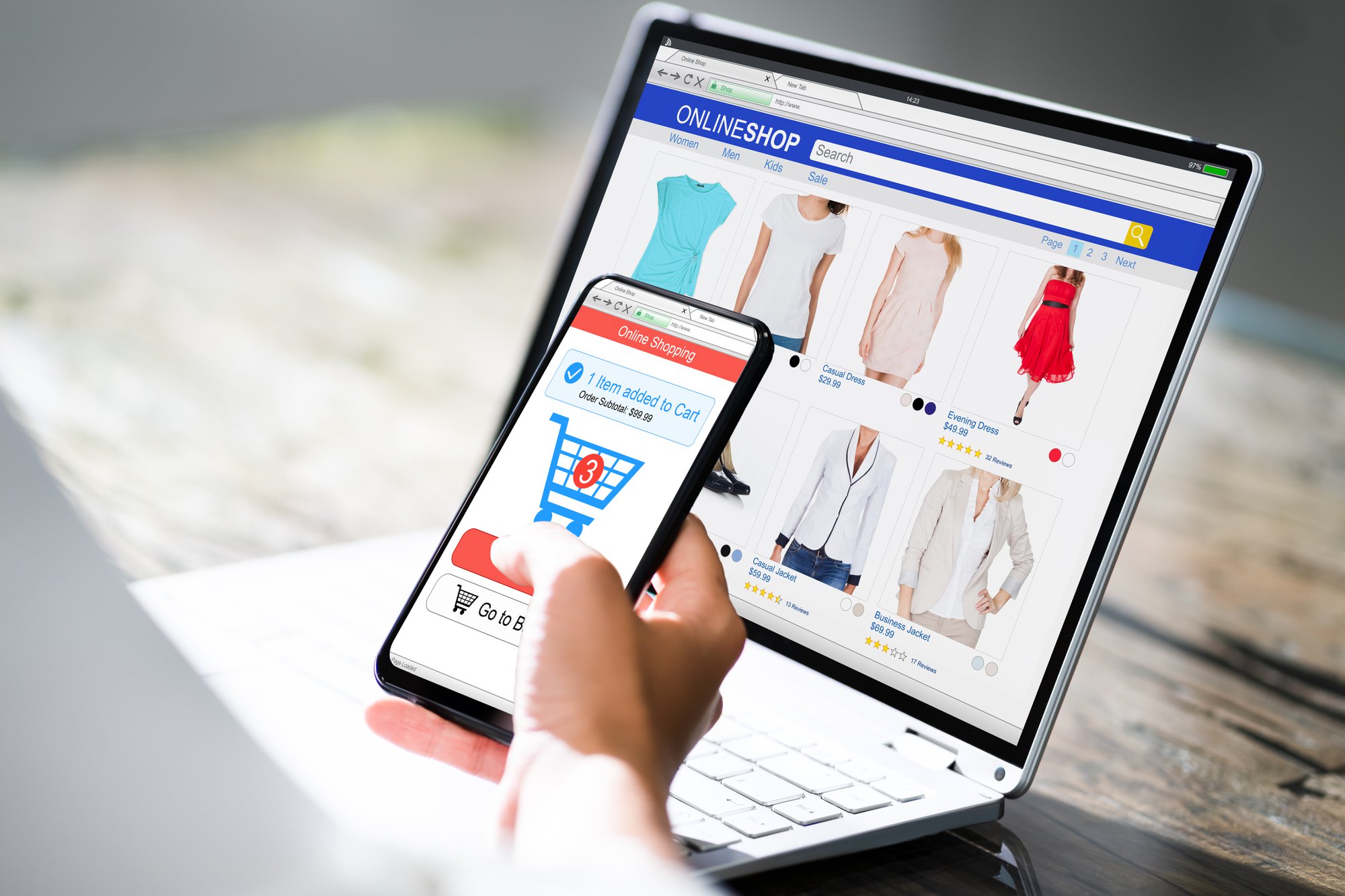Online shopping has gone from a pandemic necessity to a luxury many people can’t live without. Consumers are increasingly window shopping from the comfort of their homes. In the same way that an eye-catching window display is essential for any brick-and-mortar store, online retailers need to adopt attention-grabbing visual merchandising strategies.
New eCommerce businesses are popping up every day. Although online shopping has been around for some time, the trend escalated significantly in 2020. And what, for some people, might have initially begun because of safety concerns quickly gained long-term traction.
After all, online shopping saves consumers time and an extra commute. It eliminates pitching up at a store only to find that what you’re looking for is out of stock. Moreover, it allows anyone to shop at a national or even international store that they wouldn’t have local access to. What’s not to like?
In this guide, we’ll look at seven must-do visual merchandising strategies to drive sales and win repeat customers for eCommerce businesses in 2022.

1. Sustainability in the Spotlight
Increased awareness and concern for the planet’s future have led to a greater demand for sustainable practices. Consumers vote with their wallets, and businesses with sustainable ethics are the front runners.
As a business, taking responsibility for your eco-footprint is important. In doing so, you’ll have a positive impact on not only your reputation but also your bottom line.
To appeal to the modern consumer, broadcast your sustainability endeavors front and center. Don’t hide your brand ethos at the bottom of your web page. Rather, make it a core element in your visual merchandising strategies.
Whether you’re using less packaging, sourcing recycled materials, selling sustainable products, or planting trees with every purchase, your efforts need to be genuine–and measurable. Consumers will quickly see through a “marketing hype” that’s not truly contributing in a meaningful way.
2. Leverage Social Share Functions
Search engines now use social signals in their SEO algorithms. This means that marketing efforts should aim to boost social activity as much as website activity if they want to move up the search engine rankings.
Social share buttons make it easy for online shoppers to share content on their social pages. With a simple click, they can feature your products and services on Facebook, Pinterest, Twitter, LinkedIn, and Instagram–or even via email or WhatsApp–without leaving their current browsing session. And when they do this, your business receives free marketing in addition to notching up those SEO benefits. So, how do you ensure that your audience shares content without distracting from the customer experience?
First, be selective. Look at your content carefully to determine what is–and what isn’t–worth sharing. To do this, you need to know your audience as well as the types of products that will catch the eye of other social media users. Captivating images, headlines, and meta descriptions enhance content's shareability.
If your website features interesting blogs that will help draw viewers to your home page or eCommerce store, then add sharing buttons. Again, make sure that the content is engaging and worth sharing.
Test how the content appears when users share it. Make sure images and text are clear and fit the frame. Pixelated photos or poorly displayed graphics can hurt your brand image.
Encourage users to circulate content with a call to action such as “Don’t forget to share this post!” or offer rewards for sharing. Furthermore, you could consider removing the share feature from less-popular pages or items, as a low share count might send the wrong message.
3. Omnichannel Product Data Syncing

An omnichannel approach lets users enjoy a cohesive shopping experience across multiple channels. For instance, you might see a product advertised on social media and then purchase it via the company’s mobile app. Later, you track the delivery from your desktop browser. Once dispatched, you’ll likely get an email from the store to confirm that your goods are on their way. Then, when you receive the merchandise, you may also be sent a confirmation text.
The key to making omnichannel a success is to ensure that all information is accurate and synced across every touch point. Products should look the same, cost the same, and have the same discounts no matter which online channel they appear on. Any action taken by your customer on one channel must be accurate and visible if they switch channels. For example, a buyer who adds an item to their basket on a web browser should be able to complete that transaction later via the app without having to add those items again. In the same way, sync your inventory across channels. If an article of merchandise sells out on one channel, make sure that it appears as sold out on all channels. Inconsistencies lead to mistrust.
Keep your branding, style, tone, and fonts consistent to establish a uniform and unmistakable brand presence. For example, tech giant Apple is easy to recognize regardless of where you see its branding–in-store, on a website, a social media ad, or on its products.
Smart Merchandiser offers in-depth tips to maximize margins by leveraging visual tools in omnichannel displays. Look at some of these insights in our free guide, along with practical changes you can make today.
4. Feature User-Generated Content
User-generated content (UGC) is any content– images, reviews, videos, and more–that a user creates rather than something the brand itself curates. Amazon, for example, uses UGC by giving buyers a chance to take snapshots of their purchases and vouch for products with a review. This plays a significant role in the purchasing behavior of other consumers and is an important part of your visual merchandising strategies.
In fact, feedback and social proof are often regarded as more authentic than brand messages and advertising. If customers publicly express their satisfaction with your merchandise, other consumers will likely believe the same. Using UGC on your product pages constantly reminds you that your brand and products are legit.
With eCommerce, shoppers can’t touch, feel, or physically inspect your goods. Social proof is essential to strengthen trust and boost your online reputation. This can translate into increased conversions (especially when buyers are on the fence) and higher average order values.

To incorporate UGC in your marketing plan, include high-quality images and reviews in online catalogs. Let prospective buyers get an insight into how others are using or wearing your merchandise (and how much they love it). A loyal customer may have purchased a skirt and dressed it up with a jacket or dressed it down with a pair of sneakers. If users like the look, chances are they’ll opt to buy more than just the skirt after seeing how it morphs into different styles when paired with additional items of clothing
Social campaigns with hashtags can encourage users to post about their purchases. The human touch–and relatability–makes users feel part of a community, which, in turn, leads to brand loyalty. Remember, people are professional consumers and will likely notice if you’re curating content as opposed to using UGC.
5. Have a Personalized Touch Point With Top Customers
Your most loyal customers contribute a significant portion of your sales. Placing special focus on this core group is important. It creates trust, fosters loyalty, and promotes long-term value for both your business and the customer. Take the time to let your top clients know that you appreciate them. Touch base to ensure they are happy at every step of the purchasing journey. Consumers who rate a brand highly are more likely to respond to email surveys, which, in turn, will help to improve the customer experience. Let them know that you welcome their input as one of your top clients.
Showing your customers how much their loyalty means rather than simply telling them is at the heart of relationship building. Once accomplished, customers won’t just stick with your brand, they’ll advocate for it. How you reward them depends on your brand, your products, and services, as well as the size of your business.
Rewards programs, gift cards, free samples, special deals, early sales access, and exclusive product launch events are all ways to thank loyal buyers. These benefits also make them feel part of a select brand community and may encourage them to maintain that loyalty status.
Give them a birthday freebie and connect actively with top consumers on social media. When they feel seen and acknowledged on a personal level, they’re more likely to continue their support.
Don’t forget to say thank you, whether via an annual heartfelt email or a short video. Further, if you support environmental or humanitarian initiatives, thank your customers for their contributions and showcase the work achieved with their support. For instance, “With your support, we’ve been able to plant 10,000 new trees this year. Thank you for making a difference!”
6. Optimize Your Products Pages With Business Rules Automation
In today’s fast-paced, competitive market, AI automation tools are crucial for any eCommerce business that aims to stay ahead.
AI automation touches every aspect of eCommerce, from visual merchandising strategies and customer problem resolution to data analytics and inventory. The single task of simultaneously updating inventory across multiple channels would be agonizing to do manually. How about determining best-selling items on demand and checking that they’re always featured at the top of catalogs? Additionally, ensuring each customer has immediate access to products related to their interests is impossible without AI automation tools.
AI automation uses real-time data to enhance visual merchandising strategies. By tracking clicks, page visits, and purchases in parallel, you can identify potential revenue boosters and automatically make strategic updates to catalog displays.
The right tools also allow immediate cross-channel inventory updates. This way, when an online shopper buys your last red handbag, it will no longer be available for purchase on any other channel. Moreover, if consumers see only one or two red handbags left in stock, it could drive purchase urgency.
7. Leverage Analytics for a More Personalized Experience

Current marketing technology makes it possible to know more about your customers than ever before. You can measure every aspect with customer analytics, from the number of daily views and promotional clicks to bounce rates and the time spent on your eCommerce site.
With these metrics, it’s easier to understand your site's performance holistically and pinpoint what appeals to various customer segments. As a result, you can make data-driven decisions to implement the most effective visual merchandising strategies. A tool like Smart Merchandiser leverages the analytics management feature to gain on-demand page view statistics. Further, you can easily track abandonment rates, revenue per product, and conversion rates on your catalog page without switching between dashboards.
Another benefit of tracking behavior across channels is that it allows you to gain insights into individual consumer patterns. For example, the type of product purchased as well as the price range. With relevant behavioral data, it’s possible to personalize almost every customer experience. This includes being able to send them alerts at the most opportune times and on the right channels, as well as showcasing the items they are most likely to purchase.
Elevate Your Visual Merchandising Strategies With Smart Merchandiser
Get to know your consumers, perfect your strategy, and build a loyal community with Smart Merchandiser. By investing in effective B2C visual merchandising strategies, you can position yourself as an eCommerce front-runner.
Smart Merchandiser lets you incorporate AI automation into your platform, ensuring your product merchandising is fast, accurate, and reliable. The eCommerce store management tool optimizes inventory analysis and fosters a better consumer experience by identifying the needs of online shoppers. Moreover, the user-friendly dashboard and customizable features allow your team to start working without delay.
Boost your bottom line with strategically optimized visual merchandising. Chat with a Smart Merchandiser team member today to book a demo.



